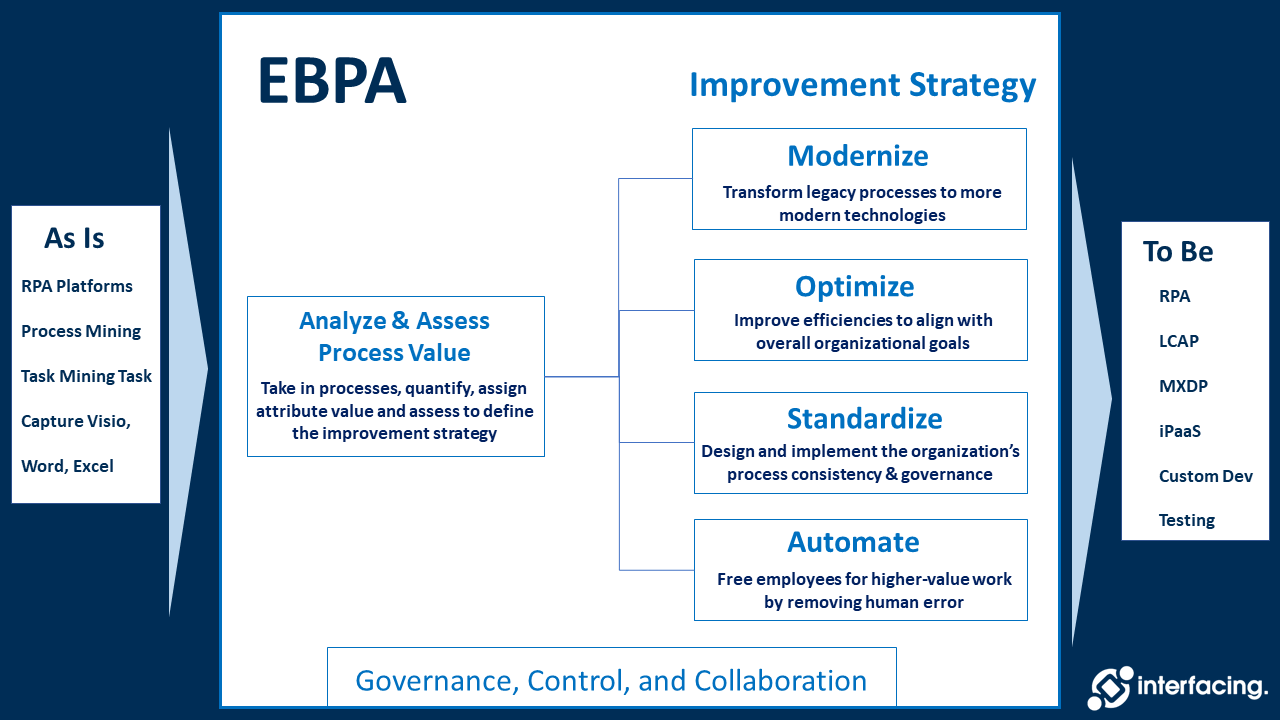Enterprise Business Process Analysis: What Is It?
According to Gartner®, who coined the term EBPA:
EBPA is the discipline of business and process modeling aimed at transforming and improving business performance with an emphasis on cross-viewpoint, cross-functional analysis to support strategic and operational decisions. EBPA is based on the principles of collaboration, short-cycle delivery, lightweight but robust modeling, and model governance. The two key principles of EBPA are “see the whole” and “understand the value network….” EBPA tools are of interest to business architects, enterprise architects, process architects, process analysts and process owners looking to transform and/or optimize their process-related outcomes.
Finding a way to make better business decisions is one of the biggest challenges for organizations. Companies must comprehend how their current operations work in order to face and overcome this challenge.
And that can only be achieved by having a thorough understanding of the core business processes of your company as well as the ability to visualize them. The business discipline known as Enterprise Business Process Analysis (EBPA) outlines how to gain this in-depth understanding in order to enhance your company’s operations and make wiser decisions.
This article helps to explain EBPA, and how it differs from other business process management (BPM) strategies, outlines its advantages, and more.
Enterprise Business Process Analysis (EBPA) – What is it?
A structured method for examining how your organization operates and determining how to enhance the underlying business processes is called enterprise business process analysis (EBPA).
By focusing on waste and redundancies, EBPA seeks to identify which processes are effective and what needs to be improved. It then develops and implements a plan for process improvement.
See how Interfacing’s IMS solution can help your organization
What advantages does Enterprise Business Process Analysis (EBPA) offer?
Enterprise BPA offers a number of significant advantages.
The highest level of EBPA enables you to comprehend how your business operates by defining, recording, and visualizing all of the operational business processes.
The typical business uses hundreds of different systems to manage thousands of processes that can be manual, automated, outsourced, etc. That gives process waste, duplication, and general inefficiencies plenty of room to hide.
Before deciding on the best downstream transformation of that process, such as retraining, automation, lo/no-code development, etc., EBPA is the mechanism to identify and address those inefficiencies.
Enterprise Business Process Analysis improves efficiency, quality, reduces costs, and decision-making when looking at specific outcomes.
What distinguishes business process management (BPM) from enterprise business process analysis (EBPA)?
Business process management (BPM) is the umbrella term for the process of enhancing a business process through its modelling, analysis, and measurement.
The analysis of enterprise business processes (EBPA) is much more comprehensive. It aims to visualize all business processes within the organization, including interactions between business units, teams, and even systems. By imagining the entire enterprise, how value is being delivered, and then looking for ways to enhance and improve that value delivery, one can use EBPA.
What Approaches Are Used in Enterprise Business Process Analysis (EBPA)?
EBPA typically adopts a Six Sigma or Lean Six Sigma methodology.
With a set of quality controls to reduce errors and speed up execution, Six Sigma is a quantitative approach to process improvement.
Lean Six Sigma is a combination of Six Sigma and another process improvement methodology known as Lean. It prioritizes the value provided to customers while focusing on eliminating waste and streamlining the workflow.
Both methodologies have their roots in manufacturing, but they can now be applied to any process, regardless of purpose or sector.
How is Enterprise Business Process Analysis (EBPA) structured and how are the steps taken?
The following six steps make up a typical simplified approach to enterprise business process analysis (EBPA):
- EBPA-enterprise-business-process-analysis
- Choose a procedure for improvement.
- Gather information about that process.
- Examine the procedure
- Create a plan for improvement.
- Implementing and observing
Each step can be divided into additional steps. For instance, processes are measured, given a value, and then evaluated to choose the best improvement plan during the analysis phase.
The actual improvement strategy then has a wide range, including
- Re-platforming processes with current technologies is a form of modernization.
- Optimization: enhancing effectiveness and coordinating with business objectives
- Establishing organizational-wide consistency and governance through standardization
- Automating processes can eliminate human error and free up workers for higher-value work.
When should enterprise business process analysis (EBPA) be implemented?
How soon can you implement EBPA should be the question rather than when?
There are tens of thousands of processes used by businesses that conceal waste, inefficiencies, and financial losses. Organizations all over the world struggle to comprehend how their businesses function, and I don’t mean that in a redundant way.
Enterprise Business Process Analysis is the means by which you can get to that understanding in order to improve business decisions and reach your overarching goals, such as cost and efficiency reduction.
Enterprise Business Process Analysis (EBPA) is managed by who?
EBPA is a cross-functional, collaborative project. Numerous other personas are crucial to any EBPA efforts, even though process analysts and process architects will be the main owners.
To define and model the processes that will be examined and improved, process owners and subject matter experts are required.
Lines of business/business units and the decision-makers within them are frequently the EBPA sponsors and the ones who request that their processes be reviewed, improved, and changed.
Additionally, IT is always at the center of any EBPA initiatives in order to evaluate the tools required and to offer knowledge, direction, and validation given that all business processes now involve a variety of applications and systems.
What Features Are Provided by Enterprise Business Process Analysis (EBPA) Tools?
EBPA tools should, at a high level, provide the capabilities that let you easily ingest and model processes with the ability to thoroughly analyze those processes. To determine the most effective improvement plan, it is necessary to be able to quantify, attribute values, and run simulations on processes.
In order to support the state of your processes in the future and promote transformative outcomes, best-in-class EBPA solutions should also offer outputs that are independent of platform and technology. Your downstream development initiatives like RPA, iPaaS, custom development, etc. should be accelerated and improved with the help of EBPA tools that enable you to export modernized, optimized, standardized, or automated processes.
How Can Automation Be Facilitated by Enterprise Business Process Analysis (EBPA)?
Finding the best process improvement strategy after analysis is one of the key features and advantages of EBPA.
To fill their operational pipeline and scale automation, automation programs struggle to find good process candidates to automate. The EBPA offers the tools and assessment capabilities required to accurately determine whether automation is the best result for a process. This analysis will show you whether the process can be automated to be completed more quickly, with fewer errors, and with greater efficiency.
Any of the top RPA tools you might use to advance and enhance automation development and delivery will be able to sync with the automated process provided by a good EBPA solution.
What additional outputs are facilitated by enterprise business process analysis (EBPA)?
All facets of your process improvement strategy—from modernization to optimization, standardization, and automation—are essentially driven by EBPA.
Enterprise Business Process Analysis, at a more detailed level, enables the following downstream process improvement and transformation outputs:
- Low-code Application Development (LCAP)
- Platforms for Multi-Experience Development (MXDP)
- Integration Platform as a Service (iPaaS)
- Custom Development (Custom Dev) – Agile software development for custom projects
How Our EBPA Consulting Services Can Help
Our Interfacing consultants equip organizations with the tools and capabilities they need to design, model, measure, mature and automate their business. We believe it’s crucial to have the right resources and know-how that remain at the forefront while the world is evolving. Interfacing’s focus therefore goes beyond traditional transformation to also include areas such as proactive transformation through Resilience (BCP, BIA, DRR), Regulatory management and Compliance.
A key differentiator of Interfacing that puts it far beyond the competition leans on leveraging its own innovative technology solution in support of transformation programs. Interfacing’s transformation suite, combined with our consulting services, provide a digital blueprint of the enterprise to gain insight into impacts, digitalize work methods and promote collaboration. Interfacing’s software solutions deliver the transparency required to reduce complexity, improve execution and facilitates agility and change. Interfacing’s integrated management system is a one-stop-shop for managing transformation programs end-to-end.
Combined with Interfacing’s industry leading digital Integrated Management System (IMS) its flagship product EPC, will significantly strengthen collaboration within IT development and operations. Your team will create, streamline, test, automate and deploy limitless workflows faster and with greater accuracy & efficiency.
Interfacing’s Enterprise Process Center® digital platform solution helps you maintain a complete library of:
- Processes
- Procedures
- Roles & responsibilities
- Risks & controls
- All regulatory requirements and standard controls
- Internal policies
- Aligned indicators (KPIs)
- Controlled indicators (Monitoring)
Why Interfacing?
Interfacing’s IMS solution provides you with out-of-box automated workflows that can be leverage for best practices, and that is built on top of a low-code platform, making it flexible and adaptable to your business processes beyond the standard workflows and easily extendable.
Minimize the manual compliance burden and improve product quality by automating critical quality processes like document, quality event, training, and audit management in a single end-to-end Enterprise Process Center solution. Ultimately, this will make your quality automation efforts easier and more efficient throughout your organization.
Contact us more for information.
Gain Transparency with the Enterprise Process Center®
Interfacing’s Digital Twin Organization software provides the transparency and Governance to improve Quality, Efficiency and ensure Regulatory Compliance.
Read Our Blogs
Take a moment to read blogs about GXP, Regulatory Compliance, today’s trends, and much much more!
Discover how your organization benefits from an Interfacing solution.
A key differentiator of Interfacing to other digital and business transformation consulting firms is that Interfacing offers its own innovative technology solution in support of transformation programs. Interfacing’s software solutions deliver the transparency required to reduce complexity, improve execution and facilitates agility and change.
Interfacing’s Integrated Management System is a one-stop-shop for managing transformation programs. We know it’s a very competitive environment out there. It is for that reason our strength is in our commitment to maintain flexibility throughout the project lifecycle whether it is in our innovative products or in our team of experts.
Try It Now For Free!
Document, improve, standardize, and monitor your business processes, risks and performance with Interfacing’s Business Process Management Software (BPM Software) the Enterprise Process Center®!







